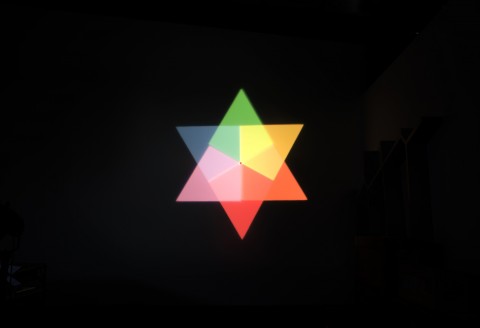
Tucked into Southern California in the 1960s, Light and Space is a little-known art movement that was overshadowed at the time by East Coast Minimalism and has been generally overlooked ever since. With this exhibition, the Fruitmarket is hoping to redress the balance. The main practitioners were active in the 60s and 70s; this exhibition seeks to establish their legacy, displaying the work of artists who respond to and were influenced by the original Californian movement. The leaflet accompanying the exhibition suggests that it offers ‘a respite from the digitally mediated contemporary world’, re-focusing on the relation of the body to surrounding space and light.

Olafur Eliasson, Ephemeral afterimage star, 2008. Courtesy the artist and Tanya Bonakdar Gallery, New York
The huge, airy, white-washed walls of the Fruitmarket are perfect for this type of art, able to give light room to breathe. Unlike the object-based East Coast Minimalism, the Light and Space movement attempted to create work that was created as it was viewed, placing the focus on experience and change. As such, the flatter, static pieces are the least successful. James Welling’s photos of light spiking through buildings, whilst pretty and furiously Instagram-friendly, fail to capture the sense of movement of light in a space, and the way that the viewer can distort and play with the work simply by moving. Similarly, Ula Barth’s …and to draw a bright light line with light (Untitled 11.5) is a flat and uninspiring depiction of a hand drawing a wiggle of whiteness across a similarly vague background.
It’s those works that have an element of movement or of intangibility that are the most tantalising. Ann Veronica Janssens’ June, a yellow plastic bar, is dull and looks like collateral, but her Yellow Rose, with several yellow lights pointing into a wall of mist, is sublime, and one of the best works in the exhibition. As you walk round, the mist dissolves and re-appears, the lights casting faint glows like buttercup shadows on the opposite walls. Also transfixing is Olafur Eliasson’s Ephermeral afterimage star, with several spotlights projecting geometric shapes of coloured light, leaving prints behind your eyes, and Tacita Dean’s Disappearance at Sea, a beguilingly haunting piece of filmmaking. Simple abstract plays of light flitter over the screen, hinting at objects and landscapes – a lantern, a rocky cliff – whilst retaining the potential to be, and mean, something more.
This is no revolution for California Space and Light; the exhibition is small and the work patchy, so is unlikely to inspire some eager curator to do a retrospective on the original movement. However, it provides a captivating look at light distinct from that which glares from our phone and computer screens.
3***
November 2015 – February 2016
by Sibylla Kalid

Leave a Reply